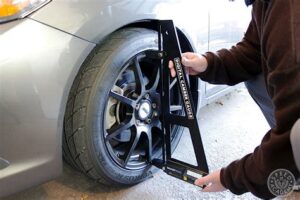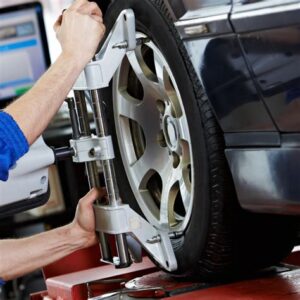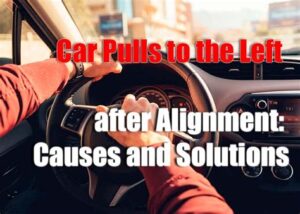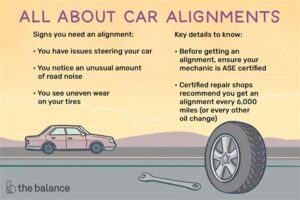Discover common signs of tire issues, including uneven wear, vehicle pulling, crooked steering, vibrations, and squealing tires, to ensure a smooth and safe drive.Is your car not handling quite like it used to? Proper alignment is crucial for the longevity of your vehicle and the safety of your journey. Over time, road conditions, daily driving, and even minor accidents can lead to misalignment, causing a host of driving issues. In this blog post, we’ll explore the key signs that indicate your car may need an alignment. From uneven tire wear that can compromise your vehicle’s performance to a steering wheel that seems off-kilter, these indicators can help you spot potential problems early. Keep your ride smooth and safe by understanding the warning signs your car is trying to communicate. Read on to find out if your vehicle needs a little adjustment!
Uneven Tire Wear
Uneven tire wear is one of the most obvious signs that your car needs an alignment. If you notice that the tread on your tires is wearing down irregularly, it may indicate that your vehicle’s wheels are not properly aligned. Common patterns include more wear on the inside or outside edges of the tire, which means that your car is likely experiencing misalignment.
The health and performance of your tires are vital for safety and efficiency. Driving on tires with uneven wear can lead to decreased mileage and increased risk of blowouts. It is crucial to monitor not just the depth of the tread, but also the overall wear pattern. Regularly inspect your tires and consult a professional if you notice any discrepancies.
If you’re unsure about the condition of your tires, you can perform a simple test. Check if the tires are wearing more on one side than the other. If this is the case, it’s time to get a wheel alignment to ensure your tires wear evenly and contribute to a smoother driving experience.
Vehicle Pulling to One Side
Your vehicle’s alignment plays a crucial role in its overall performance, and one of the strongest indicators that your car might need an alignment is when it starts pulling to one side. This condition can make driving unsafe and uncomfortable and could lead to uneven tire wear if not addressed promptly.
When a car is pulling to one side, it often feels as if you are fighting against the steering wheel to keep the vehicle centered in the lane. Not only is this a sign that an alignment issue exists, but it can also be a symptom of other underlying problems such as tire pressure discrepancies or worn suspension components. Always check your tire pressure first; if they are properly inflated, then it’s time to consider an alignment check.
Ignoring this sign could lead to more serious issues down the line, including potential damage to your tires, suspension, and steering systems. Visiting a qualified technician for a wheel alignment will ensure that your vehicle drives straight, improves fuel efficiency, and enhances safety on the road.
Crooked Steering Wheel
A crooked steering wheel can be an alarming sign that your car may need an alignment. This symptom often indicates that your vehicle’s wheels are not aligned correctly. When you drive straight, the steering wheel should ideally be centered and parallel to the ground. If it isn’t, you might find yourself constantly correcting your steering to keep the vehicle moving straight.
There are several factors that can contribute to a crooked steering wheel. This includes hitting potholes or curbs, worn-out suspension components, or simple wear and tear over time. To address this issue, it’s crucial to get your vehicle inspected by a professional. They can conduct a thorough examination and determine if an alignment is necessary to correct the steering angle.
Driving with a crooked steering wheel not only affects your comfort but can also lead to uneven tire wear, which may result in additional costs for replacements. Regular maintenance and prompt attention to steering issues can help prolong the life of your tires and improve your driving experience. If you notice your steering wheel is skewed, don’t hesitate to schedule an alignment check!
Vibrations in Steering Wheel
Experiencing vibrations in your steering wheel can be a concerning issue that often indicates your vehicle needs an alignment. When the steering wheel vibrates, it can disrupt your driving experience and even signal underlying problems such as misalignment or balance issues.
Vibrations can occur at various speeds, and the nature of the vibrations can also vary. For instance, if you feel a constant vibration at certain speeds, it may be related to tire balance issues or misaligned wheels. On the other hand, if the vibrations are intermittent, it could point to other mechanical issues like damaged suspension components.
To address the issue of vibrations in the steering wheel, it’s essential to have your vehicle inspected promptly. Ignoring this symptom can lead to more severe problems over time, affecting the performance and safety of your vehicle. Consider visiting a qualified mechanic for a detailed inspection and to ensure your car is aligned correctly.
Squealing Tires
If you hear a high-pitched noise coming from your tires while driving, this is a clear sign that something is not right. Squealing tires often indicate issues with your vehicle’s alignment, among other potential problems. Understanding these signs can help prevent further damage and improve your vehicle’s performance.
One of the most common causes of squealing tires is misalignment. When your tires are not properly aligned, they can wear unevenly, leading to increased friction and noise. This issue can arise from hitting a pothole, curb, or even from normal wear and tear. If you notice that your tires are making a squealing sound, it’s crucial to have them checked for alignment issues.
In some cases, the squealing could also indicate that your brake pads are worn down or that your tires need proper inflation. Always listen to your vehicle; any unusual sounds can be a warning sign that maintenance is required. Routine checks and proper care help ensure safety on the road and prolong the life of your tires.
Frequently Asked Questions
What are the key signs that indicate my car needs an alignment?
Some common signs include uneven tire wear, the steering wheel being off-center, and the car pulling to one side while driving.
How can I tell if my steering wheel is misaligned?
If your steering wheel is not centered when driving straight or vibrates while you drive, this could indicate an alignment issue.
What impact does misalignment have on tire wear?
Misalignment can cause uneven tire wear, leading to faster deterioration of your tires and potentially requiring more frequent replacements.
How does driving on rough roads affect my car’s alignment?
Driving on rough roads, hitting potholes, or curbs can jolt your car’s suspension system, leading to alignment issues.
Can I align my car myself?
While some may attempt to align their cars using DIY methods, it is recommended to have a professional technician perform the alignment for precision and safety.
How often should I get my car’s alignment checked?
Typically, you should have your alignment checked every 6,000 miles or if you notice any of the signs of misalignment mentioned earlier.
What are the long-term effects of ignoring alignment issues?
Ignoring alignment issues can lead to poor vehicle handling, increased tire wear, lower fuel efficiency, and can affect safety while driving.





